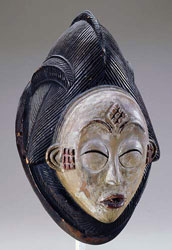


 peoples, like their neighbors the Kota, the Lumbo, and the Punu, keep reliquaries of important ancestors in shrines protected by ancestor guardian figures. These figures are placed on top of a basket containing bones. Sometimes bundled relics are attached directly to the figures. Each of these peoples has a different way of representing anthropomorphic guardian figures, ranging from idealized naturalism to abstraction.
peoples, like their neighbors the Kota, the Lumbo, and the Punu, keep reliquaries of important ancestors in shrines protected by ancestor guardian figures. These figures are placed on top of a basket containing bones. Sometimes bundled relics are attached directly to the figures. Each of these peoples has a different way of representing anthropomorphic guardian figures, ranging from idealized naturalism to abstraction. Among the Tsogho, both women and men of the Bwiti society have sanctuaries. The side-columns at the entrance are decorated with male and female figures which derive from Tsogho mythology.
Among the Tsogho, both women and men of the Bwiti society have sanctuaries. The side-columns at the entrance are decorated with male and female figures which derive from Tsogho mythology. The Lumbo and Punu peoples use mourning masks to invoke female spirits. These masks express an ideal of female beauty. They intervene in the villages on important occasions such as deaths and epidemics in order to bring harmony and well-being.



